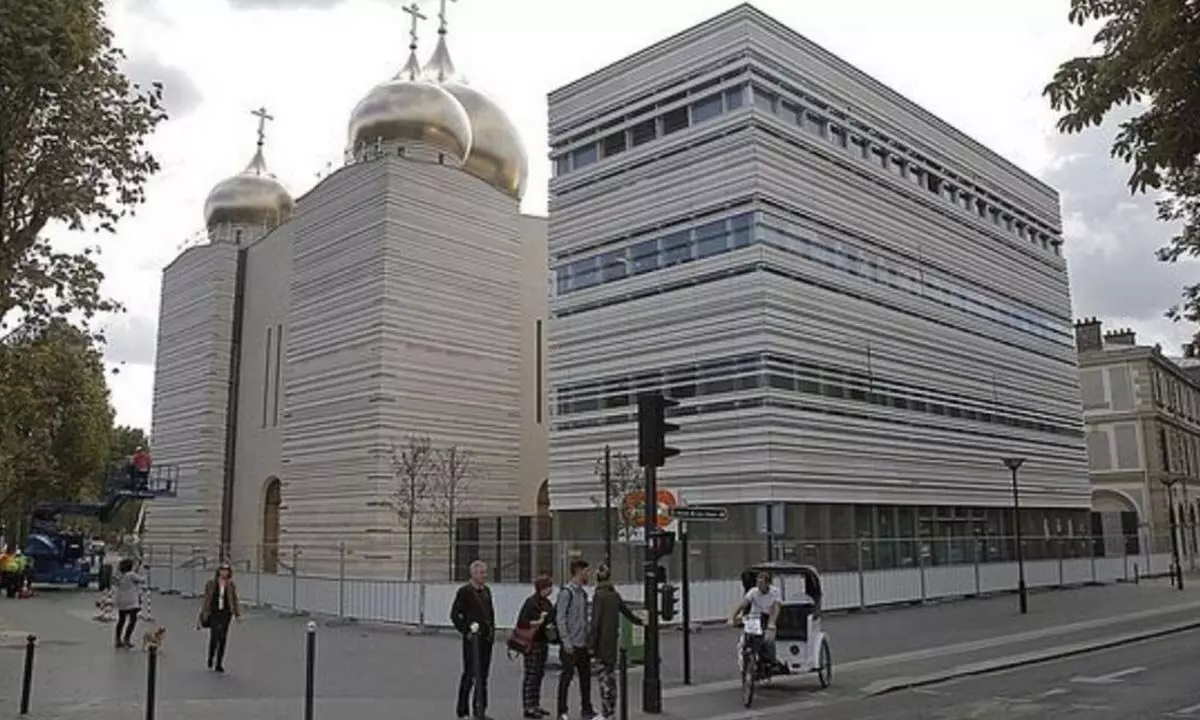Exploring enchanting realm of Paris

One of the 30 bridges which is a pedestrian bridge on the ‘Seine River,’ the lifeblood of Paris, the ‘Pont des Arts’ is famous for the ‘Love Lock Tradition’ which became quite famous in Paris.
One of the 30 bridges which is a pedestrian bridge on the ‘Seine River,’ the lifeblood of Paris, the ‘Pont des Arts’ is famous for the ‘Love Lock Tradition’ which became quite famous in Paris. It is a very interesting and human interest belief, where couples attach padlocks to a bridge and throw away the key as a symbol of their everlasting love. Over a period, the ‘Pont des Arts Pedestrian Bridge’ was covered with thousands of locks, turning it into a kind of monument to romance, but in the process, the weight of these locks began to damage the bridge, leading to safety concerns. A decade ago, in 2015, authorities removed the locks and replaced the bridge's railings with glass panels to prevent further damage. Despite this, the tradition continued in other locations, and Paris is still full of romantic spots.
The Sacre-Cœur Catholic Church area located on Montmartre Hill, the highest point in Paris, became another popular location for couples to attach love locks to railings and fences around the church contributing to the city’s romance culture. Sacre-Cœur Basilica is a major landmark known for its stunning white-domed architecture and panoramic views of Paris. It was built between 1875-1914 as a symbol of national reconciliation after the Franco-Prussian War and the Paris Commune.
Montmartre is a picturesque place in Paris, known for its rich artistic history, charming streets, and stunning views of the city, and once home to famous artists like Picasso and Van Gogh. The reason for the presence of love locks in this area is largely due to its romantic and scenic appeal. The Church itself is a major landmark that attracts many visitors, making it a natural spot for the love lock tradition to take root. The Church is noted for its Romanesque-Byzantine style, expansive mosaics, and the vast piazza in front, which offers one of the best viewpoints in the city.
Another interesting place we passed through was the ‘Pont de l'Alma Tunnel’, the tragic site where Princess Diana died in a car crash in August 1997. Located near the Seine, the tunnel has become a somber point of reflection for visitors. Above the tunnel, the ‘Flame of Liberty’ a full-sized replica of the Statue of Liberty's torch, originally a gift from the United States, has become an unofficial memorial for Diana, where people leave flowers, messages, and tributes in her memory.
Paris hosts several Russian Orthodox churches, each with its own significance. These churches reflect the rich cultural heritage and historical presence of the Russian Orthodox community in Paris, each contributing to the city’s diverse spiritual and architectural landscape. ‘Saint-Alexandre-Nevsky’ is built to serve the Russian aristocracy, Orthodox and diplomatic community in the city. It features ‘Ornate Onion Domes and Intricate Frescoes. ’ ‘Russe de la Sainte-Trinite,’ Church ‘de la Protection-de-la-Mère-de-Dieu,’ ‘Saint-Serge-de-Radonege,’ and ‘Chapel of the Russian Orthodox Church’ are the other churchesof Russian architectural style. The ‘Ritz Paris’ with its elegance, opulence, and high society is one of the most iconic and luxurious hotels in the world, located in the heart of Paris. The hotel has hosted royalty, celebrities, and artists over the years, with its lavish suites, legendary bar, where Hemingway was a frequent guest. Paris is equally renowned for its charming wayside restaurants, often referred to as ‘Bistros’ or ‘Brasseries’that have been in operation for decades, typically adorned with outdoor seating, creating a warm and inviting atmosphere where locals and tourists alike can enjoy a leisurely meal and variety of French classics like croissants, escargots, and Frech Fries.
While Parisians generally welcome tourists as they contribute to the city's economy and cultural exchange, there appears to be a preference for a balanced flow of visitors. Popular tourist areas can become crowded, leading to occasional frustration among locals. And, hence, the city has been working on managing tourism sustainably, promoting less crowded areas and encouraging responsible tourism practices, reflecting Paris's unique lifestyle.
Paris is a global fashion capital, home to some of the most luxurious shopping centers in the world. On the way we saw, ‘Louis Vuitton’, the largest high-end flagship store in Paris, a symbol of luxury and fashion, an architectural masterpiece, blending modern design with traditional elegance, offering an extensive collection of the brand's iconic bags, luggage, accessories, and clothing, and providing a premium shopping experience for fashion enthusiasts and luxury seekers from around the globe. There is always a long queue to enter the store. The others in Paris are: Le Bon Marche, Galleries Lafayette,Printemps etc. are famous shopping streets.
We passed through the historic ‘Le Marais’ district, which is the heart of the Jewish community in Paris. It is home to numerous Jewish shops, restaurants, and temples. Yet another interesting place is the ‘Le Marais’, a central hub for the ‘LGBTQ+ Community’ (lesbian, gay, bisexual, transgender, and queer) known for its lively gay-friendly atmosphere, with numerous bars, clubs, and cafes. Close to this in the ‘Les Halles’ area also a number of LGBTQ+ friendly establishments are there. Similarly, ‘Montmartre’ area has a historical association with the LGBTQ+ community. Paris generally welcomes diverse neighborhoods and communities.
Typically, Paris City has a ‘Famous Prostitution Area.’ Historically, ‘Pigalle Area’ particularly around Boulevard de Clichy, has a reputation for its adult entertainment venues and has been a focal point for discussions about sex work in Paris, and has been known for its association with sex work and nightlife. Pigalle retains some of its historical character, while ensuring that the area remains safe and welcoming for all residents and visitors.
Paris streets by and large remained narrow due to historical preservation and it is said that widening would disrupt the historical and architectural integrity of many neighborhoods.The city’s planning focuses on preserving the character of its historic districts, which often means maintaining existing street layouts rather than expanding them.The close alignment of buildings along streets that were designed before the advent of modern urban planning, helps create a dense, walkable urban environment. Driving or walking through Paris, it is seen that the ‘Road Traffic and Parking Discipline’ is unique.
To reduce road traffic and pollution, various measures were taken, such as expanding pedestrian zones, implementing car-free days, and promoting use of public transport and bicycles. Paris has limited parking spaces and enforces orderly parking practices to manage space efficiently.
Double parking or zigzag parking is rare. Paris City has low use of two-wheelers unlike other cities. The strict parking regulations discourage the use of scooters and motorcycles, as finding parking can be challenging. It is a compact city making walking and cycling convenient and practical, and encourages pedestrian and cyclist mobility. Dedicated bike lanes and pedestrian zones are seen.
Paris is famous for its old-looking apartmentswith their grand façades, that open directly onto the streets, wrought-iron balconies, high ceilings, etc. These buildings were constructed before modern zoning laws, leading to a blend of residential and commercial uses. Their value can vary significantly depending on the location, though they still offer the charm of ‘Parisian Architecture’ reflecting the neighborhood's prestige, proximity to landmarks, and the level of renovation the apartments have undergone.
Their design fosters a lively, street-level environment, encouraging interaction between residents, businesses, and visitors, and promoting a sense of community and vibrancy, with shops, cafes contributing to the city's lively street life. However, Street vending and pavement shops are regulated tightly in Paris to maintain order and aesthetics. The city has strict rules governing where vendors can set up, leading to fewer such shops.Most commercial activities are concentrated in designated areas such as markets and shopping districts rather than on the pavements. This is the ‘Cultural, Historical, and Artistic Richness of Paris.’ (Dispatch from Amsterdam)















